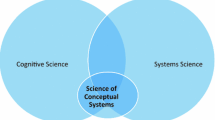Abstract
A useful term cannot apply to everything. Some logical or conceptual boundary must appear somewhere. As we saw, the word “not” helps us to locate these boundaries; to know what is being denied is to have perceived half of what is being asserted.
Similar content being viewed by others
Notes
- 1.
The index of Halliburton’s book cites this as the definition of “glycogen.”
- 2.
“A calculus designed to represent electrical theory will be constructed so that its final formulae express propositions about observable flashes of light or pointer readings of a measuring instrument; like a zip-fastener, each side will be firmly attached at one end.” (1959, 51).
- 3.
“In general, we mean by any concept nothing more than a set of operations, the concept is synonymous with the corresponding set of operations.” (1927, 5).
References
Braithwaite, R. B. 1959. Scientific explanation. Cambridge: Cambridge University Press.
Bridgman, P. W. 1927. The logic of modern physics. New York: Macmillan.
Euclid. 1956. The thirteen books of Euclid’s elements. Trans. Sir Thomas L. Heath. New York: Dover Publications.
Halliburton, William Dobinson. 1936. The essentials of chemical physiology for the use of students, 13th ed. New York: Longmans, Green & Co.
Johnson, Samuel. 1963. Johnson’s dictionary: a modern selection. Eds. E.L. McAdam and George Milne. New York: Pantheon Books.
Mach, Ernst. 1960. The science of mechanics. Trans. T.J. McCormack. LaSalle, Ill: Open Court Pub. Co.
Author information
Authors and Affiliations
Editor information
Editors and Affiliations
Rights and permissions
Copyright information
© 2018 Springer International Publishing AG, part of Springer Nature
About this chapter
Cite this chapter
Lund, M.D. (2018). Defining Conceptual Boundaries. In: Lund, M.D. (eds) Perception and Discovery. Synthese Library, vol 389. Springer, Cham. https://doi.org/10.1007/978-3-319-69745-1_2
Download citation
DOI: https://doi.org/10.1007/978-3-319-69745-1_2
Published:
Publisher Name: Springer, Cham
Print ISBN: 978-3-319-69744-4
Online ISBN: 978-3-319-69745-1
eBook Packages: Religion and PhilosophyPhilosophy and Religion (R0)




